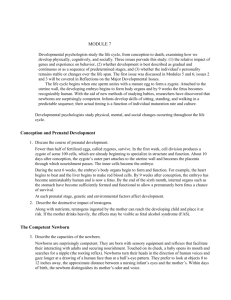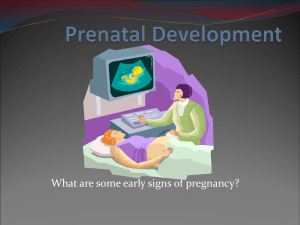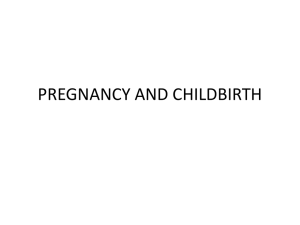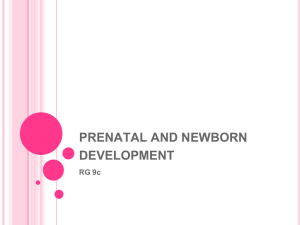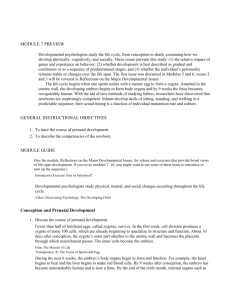Prenatal Development PowerPoint
advertisement
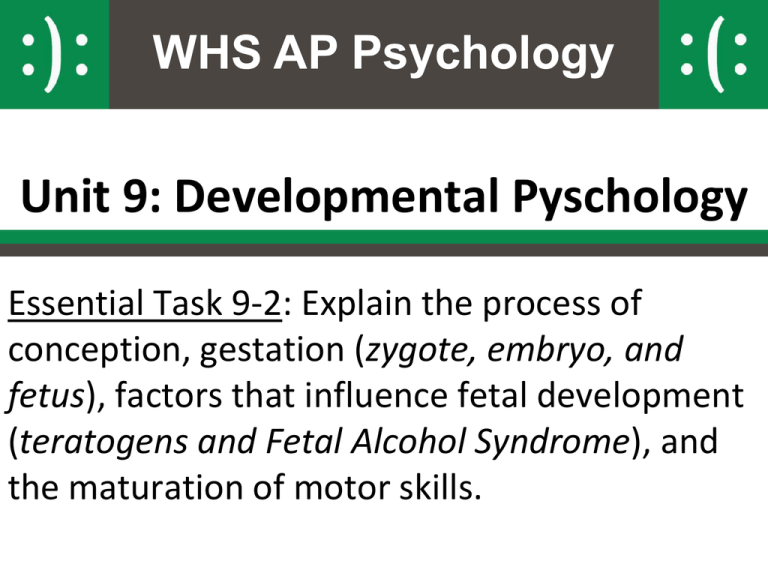
WHS AP Psychology Unit 9: Developmental Pyschology Essential Task 9-2: Explain the process of conception, gestation (zygote, embryo, and fetus), factors that influence fetal development (teratogens and Fetal Alcohol Syndrome), and the maturation of motor skills. We are here Adulthood Types of Studies Adolescence Unit 9 Developmental Psych Prenatal Development Aging Cognitive Development Piaget’s Stages Adulthood Moral Development Vygotsky’s Theory Social Kohlberg Development Erikson Parenting Styles Gender Gilligan Outline 9-2 • Gestation – Zygote – Embryo – Fetus • Factors that influence fetal development – teratogens – Fetal Alcohol Syndrome) • Developmental Norms Prenatal Development and the Newborn How, over time, did we come to be who we are? From zygote to birth, development progresses in an orderly, though fragile, sequence. Outline Conception A single sperm cell (male) penetrates the outer coating of the egg (female) and fuses to form one fertilized cell. Outline Your most fortunate of moments! Out of the 200 million sperm and 5000 eggs ‘you’ won the race. Outline Prenatal Development A zygote is a fertilized cell with cells that become increasingly diverse. At about 14 days the zygote turns into an embryo (a and b). Outline Embryo at 40 Days Embryo at 45 Days Embryo: 6 Weeks Notice the large neural tube and the formation of the heart and other internal organs. Outline Embryo: 7 Weeks Eyes, fingers, toes and most internal organs have formed, but are not yet fully functional Outline Embryo: 7 weeks • Facial features are visible, including a mouth and tongue. • The eyes have a retina and lens. • The major muscle system is developed and the unborn child moves as if practicing. • The child has its own blood type, distinct from the mother's. • These blood cells are produced by the liver now instead of the yolk sac. Outline Embryo: 8 Weeks Amniotic Sac Placenta Embryo: 8 Weeks Embryo in Amniotic sac Fetus: 8-9 Weeks • The unborn child, called a fetus at this stage, is about half an inch long. • The tiny baby is protected by the amniotic sac, filled with fluid. • Inside, the child swims and moves gracefully. • The arms and legs have lengthened, and fingers can be seen. • The toes will develop in the next few days. • Brain waves can now be measured. Prenatal Development At 9 weeks, an embryo turns into a fetus (c and d). 10 Weeks: •The heart is almost completely developed and very much resembles that of a newborn baby. •An opening the atrium of the heart and the presence of a bypass valve divert much of the blood away from the lungs, as the child's blood is oxygenated through the placenta. •Twenty tiny baby teeth are forming in the gums; some babies are even born with teeth emerging from the gums. 12 Weeks: The baby at 12 weeks: notice the webbing on the fingers, with the digits still fused Fetus: 12 Weeks • Vocal chords are complete, and the child can and does sometimes cry silently. • The brain is fully formed, and the child can feel pain. • The fetus may even suck his thumb. • The eyelids now cover the eyes, and will remain shut until the seventh month to protect the delicate optical nerve fibers. • Notice head size and chest size in comparison to an adult Fetus at 14-15 Weeks: • 14 weeks— – Muscles lengthen and become organized. – The mother will soon start feeling the first flutters of the unborn child kicking and moving within • 15 weeks— – The fetus has an adult's taste buds and may be able to savor the mother's meals. – Foods the mother eats can affect movement of the baby Fetus at 4 Months (~16 weeks) • Face is fully developed and • A downy hair covers the skin. • Face is fully formed. • Eyes are fully formed but not yet functional. 16 Weeks: • Five and a half inches tall and only six to 10 ounces in weight • Eyebrows, eyelashes and fine hair appear. • The child can grasp with his hands, suck her thumb, kick, or even somersault 20 Weeks: • The child can hear and recognize her mother's voice. • Though still small and fragile, the baby is growing rapidly and could possibly survive if born at this stage. • Fingernails and fingerprints appear. • Sex organs are visible. • Using an ultrasound device, the doctor can tell if the child is a girl or a boy. This is a baby girl. 5 Months: •Beginning to form hair on all body parts •Definite sleep/awake cycles now. •REM sleep occurs. 5 Months: •Approximately 8-10 inches long and 1 to 2 pounds •Body position is often still “head up” •Baby is viable at this point with at least a 50/50 chance of survival outside the womb. 24 Weeks: • Seen here at six months, the unborn child is covered with a fine, downy hair called lanugo. • Its tender skin is protected by a waxy substance called vernix. • Some of this substance may still be on the child's skin at birth at which time it will be quickly absorbed. • The child practices breathing by inhaling amnionic fluid into developing lungs. 30 Weeks: • For several months, the umbilical cord has been the baby's lifeline to the mother. • Nourishment is transferred from the mother's blood, through the placenta, and into the umbilical cord to the fetus. • If the mother ingests any toxic substances, such as drugs or alcohol, the baby receives these as well. 7 Months: • Room is getting tight at this point. • The baby is less able to move, squirms and pushes more than flutters and kicks. • Most babies begins to get into a head down position getting ready for birth. 32 Weeks: • The fetus sleeps 90-95% of the day with REM sleep dominating the sleep cycle, an indication of dreaming. • The baby is very viable at this point, with a 75% or higher chance of survival. • If the baby is born, the concerns are with adequate lung development. Final lung development does not occur until about 37 weeks. Birth: 38-42 Weeks • 40 weeks is normal gestation • The baby weighs on average 7 lbs. and is 20 inches long. • At birth the baby can see, hear, move and recognizes the voices of her parents or others who have been near the mother. Fetus Prenatal Development • • • • Zygote – conception to 2 weeks Embryo – 2 weeks through 8 weeks Fetus – 9 weeks to birth Placenta – Connects fetus to mother – Brings oxygen and nutrients – Takes away waste • Critical period – A time during development when influences have major effect • Teratogens – Substances that can damage an embryo or fetus Fetal Alcohol Syndrome – Occurs in children of women who consume large amounts of alcohol during pregnancy – Symptoms include facial deformities, heart defects, stunted growth, and cognitive impairments Reflexes • Rooting – Baby turns its head toward something that brushes its cheek and gropes around with mouth • Sucking – Newborn’s tendency to suck on objects placed in the mouth • Swallowing – Enables newborn babies to swallow liquids without choking • Grasping – Close fist around anything placed in their hand • Stepping – Stepping motions made by an infant when held upright Temperament • Temperament refers to characteristic patterns of emotional reactions and emotional self-regulation • Thomas and Chess identified three basic types of babies – Easy • Good-natured, easy to care for, adaptable – Difficult • Moody and intense, react to new situations and people negatively and strongly – Slow-to-warm-up • Inactive and slow to respond to new things, and when they do react, it is mild Temperament • Kagan has added a fourth type – Shy child • Timid and inhibited, fearful of anything new or strange • Temperament may predict later disposition Perceptual Abilities • Vision – Clear for 8-10 inches – Good vision by 6 months • Depth perception – Visual cliff research • Other senses – Ears are functional prior to birth – Infants particularly tune in to human voices – Taste and smell are fully functional Cognitive Development in the Newborn Investigators study infants becoming habituated to objects over a period of time. Infants pay more attention to new objects than habituated ones, which shows they are learning Developing Brain The developing brain overproduces neurons. Peaking around 28 billion at 7 months, these neurons are pruned to 23 billion at birth. The greatest neuronal spurt is in the frontal lobe enabling the individual to think rationally. Physical Development • Children grow about 10 inches and gain about 15 pounds in first year • Growth occurs in spurts, as much as 1 inch overnight • Growth slows during second year Maturation • The development of the brain unfolds based on genetic instructions, causing various bodily and mental functions to occur in sequence— standing before walking, babbling before talking—this is called maturation. • Maturation sets the basic course of development, while experience adjusts it Motor Development • Developmental Norms – Ages by which an average child achieves various developmental milestones – First, infants begin to roll over. Next, they sit unsupported, crawl, and finally walk. – Experience has little effect on this sequence. Maturation and Infant Memory The earliest age of conscious memory is around 3½ years (Bauer, 2002). A 5-year-old has a sense of self and an increased long-term memory, thus organization of memory is different from 3-4 years.

